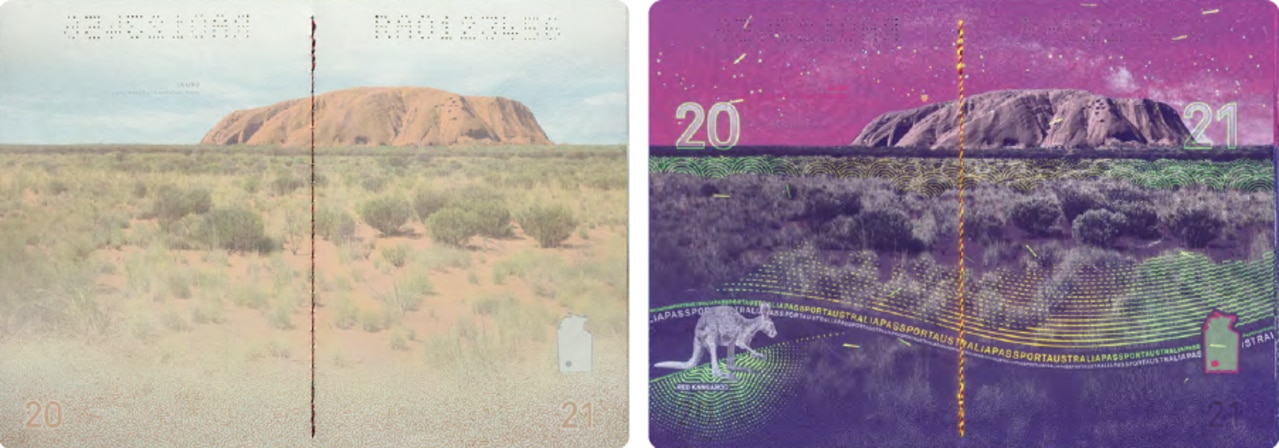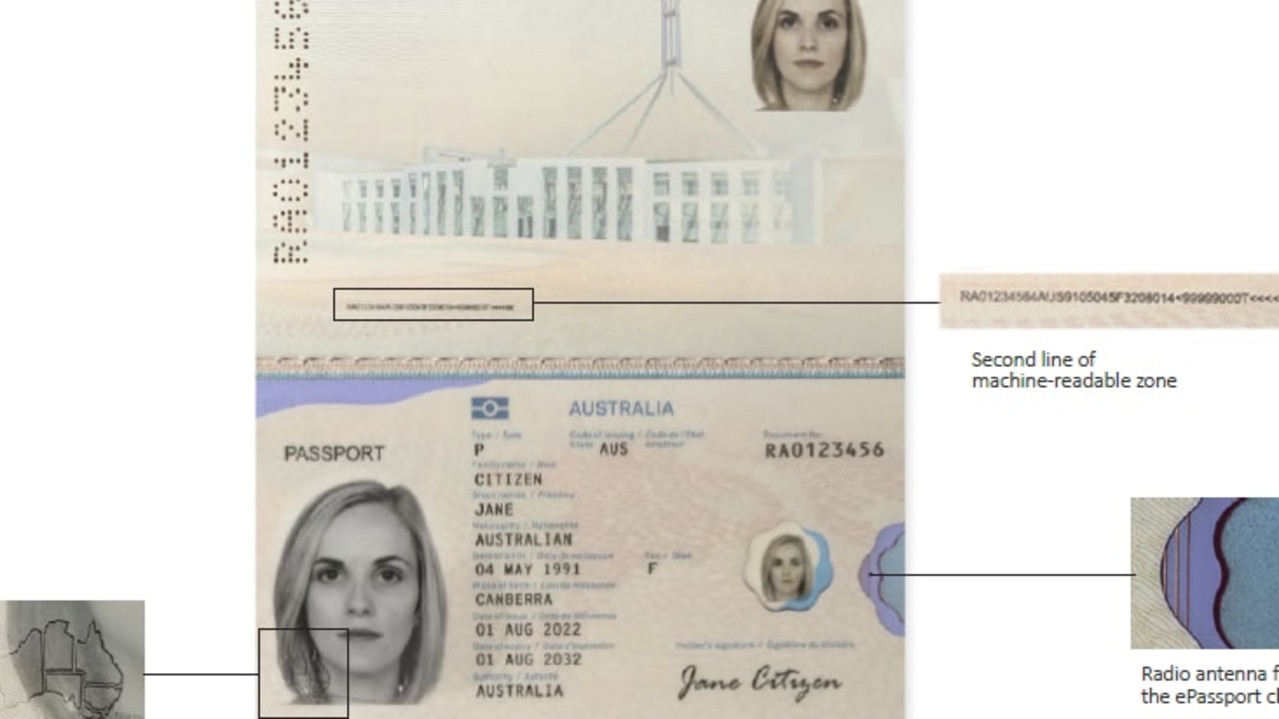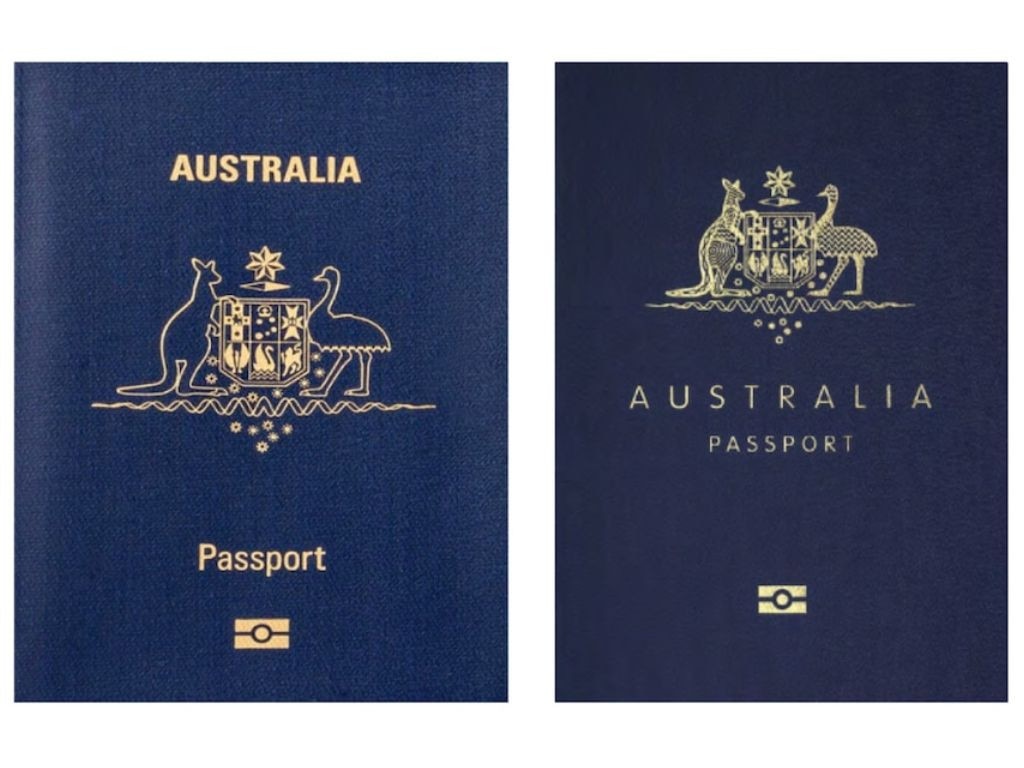‘Hi-tech’ hidden images in new Aussie R Series passport
DFAT has released a new “hi-tech” Aussie passport, with secret images printed in invisible ink and a microchip to store data.
A pricey new Aussie passport has been released by the Department of Foreign Affairs, and it’s packed with hi-tech features including a radio antenna and hidden images of native animals printed in invisible ink.
The passports are slightly more expensive than they were two years ago, but they come laden with security measures, pretty pictures and an unexpected tribute to the late Queen — and DFAT insists they are “visually stunning”.
Invisible, ultraviolet ink
The new passport’s visa pages feature 17 prints of iconic Australian landscapes.
When placed under ultraviolet light, though, the images transform into nightscapes, each displaying a hidden species of native fauna.
A page featuring Uluru, for instance, transforms into a vibrant pink and purple nightscape, with a grazing kangaroo in the left corner and Indigenous art hidden in the desert bush.
The front cover of the passport showcases a slick new design, while a jaunty kangaroo hops across the back cover.
On the first inside page, the passports also contain a surprising tribute to the late Queen Elizabeth II.
The reference to “Her Majesty Queen Elizabeth the Second” as the country’s head of state will remain, at least for now, as DFAT says more than a million pages had been printed before King Charles took the throne.

Changes to the photo page
The holder’s passport photo now appears three times on a freshly redesigned photo page.
The new photo page is made out of tough, layered plastic known as polycarbonate. The material is laser-engraved, not printed with ink, and DFAT says it’s less susceptible to wear and tear.
The identifying photo appears twice in black and white — once in its usual spot, and once slightly to the right — and a third time in colour on the preceding page.
A radio antenna
Also on the photo page is a small antenna that allows the new documents to be ePassport enabled.
A small window reveals an embedded ePassport chip on the right hand side of the page. It features three parallel lines running across it — these lines are the antenna.
The chip contains information about the passport holder’s identity, which is shared wirelessly at ePassport gates, smoothing out the once-arduous customs process.

How much does a new passport cost?
The new passport, with all its flash features, has come under scrutiny for its cost, with Aussie travellers slugged with record fees for passports in 2023.
At a steep $325, up from $308 last year and $301 in 2021, the passport is among the world’s most expensive.
In comparison, New Zealanders pay about $NZ199 (about $A180), the British pay £85 (about $140), and a Portuguese passport costs just €65 (about $100).
Canadian, Greek and Maltese passports all allow for the same amount of visa-free travel as an Australian one, but cost significantly less for their respective citizens.
Why do Australians need a new passport?
It’s international best practice for countries to update their passports every 5-10 years, usually with new security features and a design refresh.
The plans to transition to the new model have been in the works since 2015.
“The transition to the R Series is necessary now to continue to ensure the safety of Australians’ identities to the highest possible standards,” DFAT said.
“To thwart document fraud, we must regularly upgrade the Australian passport’s security features.”
Australia’s previous passport, the P Series, has been in use since 2014.

Do you need to replace your old passport?
You do not need to replace your current passport with the new R Series.
Your current passport is still valid until it hits its expiry date, and DFAT says the document is still highly secure.
However, many airlines and governments require travellers to carry a passport that has at least six months left on its validity — so it’s important to check the entry requirements of your destination before you fly.
How long does it take to get a passport?
DFAT recommends those in need of a new passportallow at least six weeks to get one — but the department has been plagued by delays since international borders opened in late 2021.
In August 2022, about 40,000 Australians had not received their passports after six weeks.
DFAT blamed the delays on “unprecedented demand” after 1.8 million Australians renewed their passports while borders were still closed.
The introduction of the new R Series shouldn’t increase wait times, DFAT said. In fact, it says one million versions of the new documents had rolled off the production line as of last week.
How powerful is the Australian passport?
More Coverage
The Australian passport is one of the world’s most powerful, allowing visa-free travel to 185 countries according to the latest Henley & Partners Passport Index.
Australia ranked eighth on the index, alongside Canada, Greece and Malta. It fell behind 22 countries that ranked on higher tiers.
Japan placed first, for the sixth year in a row.






